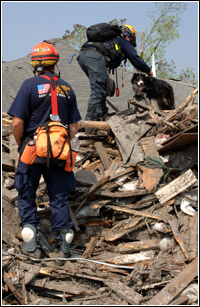 Overview
Overview
If a disaster event warrants national US&R support, FEMA will deploy the three closest task forces within six hours of notification, and additional teams as necessary. The role of these task forces is to support state and local emergency responders' efforts to locate victims and manage recovery operations.
Each task force consists of two 31-person teams, four canines, and a comprehensive equipment cache. US&R task force members work in four areas of specialization: search, to find victims trapped after a disaster; rescue, which includes safely digging victims out of tons of collapsed concrete and metal; technical, made up of structural specialists who make rescues safe for the rescuers; and medical, which cares for the victims before and after a rescue.
In addition to search-and-rescue support, FEMA provides hands-on training in search-and-rescue techniques and equipment, technical assistance to local communities, and in some cases federal grants to help communities better prepare for urban search-and-rescue operations.
The bottom line in urban search-and-rescue - someday lives may be saved because of the skills these rescuers gain. These first responders consistently go to the front lines when America needs them most. We should be proud to have them as a part of our community.
Not only are these first responders a national resource that can be deployed to a major disaster or structural collapse anywhere in the country. They are also the local firefighters and paramedics who answer when you call 911 at home in your local community.
US&R History
In the early 1980s, the Fairfax County Fire & Rescue and Metro-Dade County Fire Department created elite search-and-rescue (US&R) teams trained for rescue operations in collapsed buildings. Working with the United States State Department and Office of Foreign Disaster Aid, these teams provided vital search-and-rescue support for catastrophic earthquakes in Mexico City, the Philippines and Armenia.
The Federal Emergency Management Agency (FEMA) established the National Urban Search and Rescue (US&R) Response System in 1989 as a framework for structuring local emergency services personnel into integrated disaster response task forces.
In 1991, the Federal Emergency Management Agency (FEMA) incorporated this concept into the Federal Response Plan (now the National Response Plan), sponsoring 25 national urban search-and-rescue task forces.
Events such as the 1995 bombing of the Alfred P. Murrah building in Oklahoma City, the Northridge earthquake, the Kansas grain elevator explosion in 1998 and earthquakes in Turkey and Greece in 1999 underscore the need for highly skilled teams to rescue trapped victims.
The terrorist attacks on the World Trade Center and the Pentagon on September 11, 2001 thrust FEMA's Urban Search and Rescue (US&R) teams into the spotlight. Their important work transfixed a world and brought a surge of gratitude and support.
Today there are 28 national task forces staffed and equipped to conduct round-the-clock search-and-rescue operations following earthquakes, tornadoes, floods, hurricanes, aircraft accidents, hazardous materials spills and catastrophic structure collapses. These task forces, complete with necessary tools and equipment, and required skills and techniques, can be deployed by FEMA for the rescue of victims of structural collapse.




